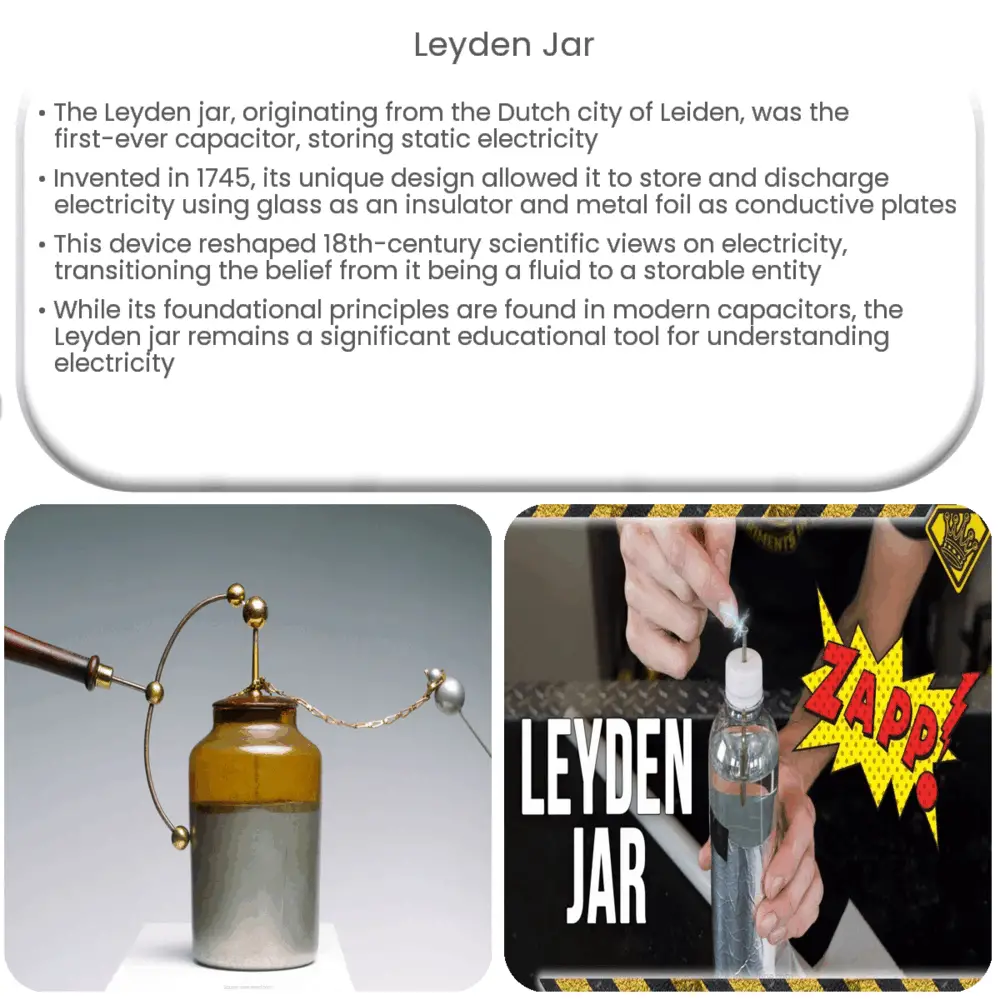Explore the history of the Leyden Jar, its design, and impact on modern capacitors. Understand its educational significance in electricity.

Leyden Jar: A Historical Overview
The Leyden jar, named after the Dutch city of Leiden where it was first invented, is a simple device used for storing static electricity. It marks a pivotal moment in the history of electricity, being the first capacitor ever invented.
Origins and Invention
The Leyden jar was developed in 1745 by two independent groups. Pieter van Musschenbroek, a Dutch scientist, and Ewald Georg von Kleist, a German clergyman, are both credited with its invention. Despite its simple construction—consisting of a glass jar partially filled with water, a conducting wire, and a cork or wooden stopper—it was capable of producing impressive sparks and shocks.
The Design of the Leyden Jar
What made the Leyden jar so unique was its ability to store and discharge electricity. The jar was typically made of glass, a material that is an excellent insulator. The inside and outside of the jar were coated with metal foil, which served as the conductive plates. The glass itself acted as the dielectric (insulator), preventing the flow of electricity between the plates. A metal rod, connected to the internal plate, protruded through the stopper at the top of the jar, providing a means for the jar to be charged and discharged.
Principle of Operation
When the rod of a Leyden jar is brought close to a source of static electricity, the inner plate becomes charged. This causes an equal and opposite charge to form on the outer plate, due to the insulating properties of the glass. The jar can store this charge until it is discharged, usually by connecting the inner and outer plates with a conductive path.
The Impact of the Leyden Jar
Despite its simplicity, the Leyden jar had a significant impact on the scientific community of the 18th century. It demonstrated that electricity could be stored and released, contradicting the prevailing belief that electricity was a fluid that could only flow. This opened up new avenues for research, leading to a deeper understanding of electricity and its properties.
However, the Leyden jar wasn’t without its dangers. Many early experimenters reported receiving shocks from their jars, some of which were quite severe. This led to calls for a safer design, and the first steps towards the modern capacitor were taken.
The Evolution of the Leyden Jar
Over time, the design of the Leyden jar evolved. Benjamin Franklin made significant improvements to the original design. He realized that the charge was stored in the glass, not in the water as initially thought. This led to the removal of water from the design, and the inner and outer surfaces of the glass jar were instead coated with metal foil.
Modern Capacitors and the Legacy of the Leyden Jar
The principles underpinning the Leyden jar are the same as those that govern the operation of modern capacitors, a fundamental component in today’s electronic devices. Capacitors are used in a wide range of applications, from smoothing out the power supply in a desktop computer to tuning the frequency of a radio station. They are also used in defibrillators to deliver a life-saving shock to a failing heart.
The Leyden Jar in Education
In the realm of education, the Leyden jar often serves as a useful tool for teaching the principles of electricity and capacitance. Students can construct their own Leyden jars, gaining firsthand experience with the phenomena of electrical charge, storage, and discharge.
Conclusion
The Leyden jar, despite its simplicity, played a crucial role in the history of electricity. Its invention marked the beginning of our understanding of electrical storage and discharge. It became a stepping stone for the development of the modern capacitor, an essential component in electronic technology.
Today, the Leyden jar stands as a testament to the ingenuity of early experimenters and their contribution to the world of science. It is a symbol of the vast potential that lies in exploring and understanding the natural world. The Leyden jar may be an antiquated technology, but its impact is still felt in the capacitors powering our modern world, and in the classrooms where future scientists first learn about the wonders of electricity.

